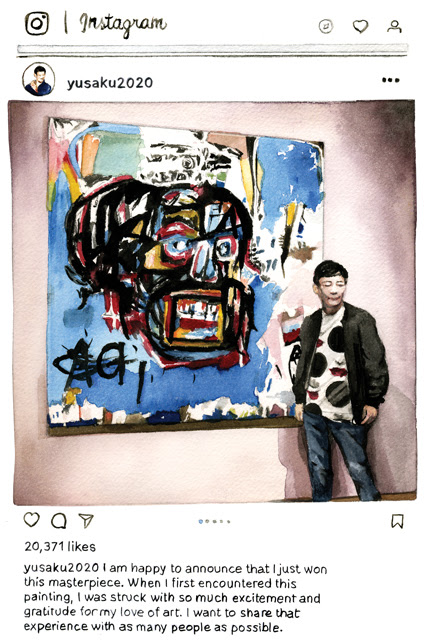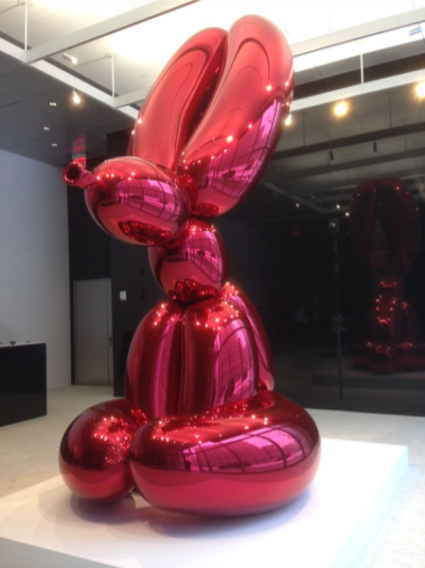An illustration of Yusaku Maezawa’s infamous Instagram post by Alexandra Compain-Tissier.
This article introduces the 2017 list of the ARTnews “Top 200 Collectors.”
Art collectors at the uppermost echelons can be a secretive coterie. In an age when some are throwing open doors to gleaming new private museums and revealing their holdings with great fanfare, there are others whose names will never appear on a list like this—because they want no one outside their inner circle to know of their exploits.
That is why it was so striking when Yusaku Maezawa posted on Instagram about the Jean-Michel Basquiat painting he purchased for $110 million at Sotheby’s in May. He did not, like many others have in the past, whisper about it to fellow collectors who then passed it down to the chattering classes. He did not grant a news-making exclusive about it to the New York Times or the Wall Street Journal. He revealed it—just like that—to anyone who might have been looking at one of the world’s most popular social-media platforms.
In that spirit, for the 28th edition of the ARTnews “Top 200 Collectors” list, we asked the connoisseurs in our survey—some of them veterans and others new to the enterprise—to tell us a bit about themselves. What are some of the pieces they have acquired over the past year? Who inspired them to start collecting? Was there ever an artwork that got away? The answers we received are grand.
In the past year, in addition to a six-panel canvas by David Hockney (Woldgate Woods, 24, 25, and 26 October 2006, dated 2006), David Geffen acquired four pieces by midcareer painter Marc Grotjahn. The New York Times recently reported that Geffen owns six of the artist’s paintings and lost out on one that sold privately for $22 million. His devotion to Grotjahn is clear: “He’s the most important artist of his generation,” Geffen told the Times.
The Whitney Biennial this year prompted impassioned declarations of generational worth—and, perhaps, sales to follow. Elham and Tony Salamé acquired work by Anicka Yi, as did Julia Stoschek, who picked up the artist’s Flavor Genome, a video from 2016 that featured in the Biennial. Though not in this year’s Biennial, Laura Owens, whose work appeared in the 2014 edition and will be the subject of a major solo exhibition at the Whitney this fall, turned up on quite a few lists, including those of the Salamés, Rosa de la Cruz, and Danny Goldberg.
This past summer’s Grand Tour—with stops at the Venice Biennale, Documenta 14, Skulptur Projekte Münster, and Art Basel—kept collectors busy. Estrellita Brodsky, for instance, acquired work by Vlassis Caniaris, a Greek artist from the 1960s whose sculpture she saw at Documenta. At Art Basel, she bought a piece by Harvey Quaytman, from 1984. Patrizia Sandretto Re Rebaudengo, Karen and Christian Boros, and Goldberg all purchased works by Katja Novitskova, who showed in the Estonian Pavilion of the Venice Biennale. And pieces by Anne Imhof, winner of the Biennale’s prestigious Golden Lion Award for the German Pavilion, went to the Rubell Family collection and Walter Vanhaerents.
As for formative influences among collectors, Rebecca and Martin Eisenberg credited the dealer and tastemaker Jack Tilton, who passed away in May, as “a great inspiration” who taught them “how to look at art, where to find great art, and how to build a collection.” Bob Rennie was among several who named his mother—though, unlike some collectors from storied families, his memories draw on more modest questions like “which Robert Wood print from Sears she would acquire and the big decision between wood frame or gold.”
Jeff Koons, Balloon Rabbit (Red), 2005-2013, in the Minskoff collection.
COURTESY EDWARD MINSKOFF
Some collectors named other honorees on our “Top 200” list among their inspirations. Brodsky and JK Brown both cited Agnes Gund, whose biggest headline this year came when she sold a Roy Lichtenstein painting to Steven Cohen for $165 million and dedicated part of the proceeds to start a criminal justice fund. Maurice Marciano, who recently opened a private museum in Los Angeles with his brother Paul, acknowledged another collector close by: Eli Broad, who two years ago launched the Broad, his own private museum in Los Angeles. The first piece Marciano ever bought was a blue monochrome by Yves Klein, in 1989. He still has it. The one that got away? A large Christopher Wool word painting he was offered a few years ago.
Jeff Koons’s name was cited by several collectors among those surveyed. His One Ball Total Equilibrium Tank (Spalding Dr. J 241 Series), 1985, was the storied first art purchase of Dakis Joannou, one of Koons’s most prodigious collectors. But for a few of our “Top 200” collectors, Koons was the one that got away. Tiqui Atencio Demirdjian wishes she had picked up his Hanging Heart (Red), from a series dated 1994–2006. David Geffen said he missed out on Koons’s silver Rabbit (1986). Anita Zabludowicz lamented “all the Koonses I wanted to buy—there were so many opportunities, but my husband did not like them.” (She added that she also missed out on Jean-Michel Basquiat, even though dealer Tony Shafrazi had offered her “the best” ones back in 1992, when she had just started collecting. “I did not understand [the work] and stopped us from acquiring them,” she said.)
Property developer Edward Minskoff named his extensive holdings of Koons works—including his Balloon Rabbit (Red), 2005–10, currently installed in the lobby of 51 Astor Place in New York—as a cornerstone of his collection. That puts Koons in good company, as other prized Minskoff holdings include Jackson Pollock’s Wounded Animal (1943), a group of Willem de Kooning figurative and abstract works, and 19 pieces by Pablo Picasso, including his bronze sculpture La guenon et son petit (1951). Minskoff’s one that got away? A 1966 Andy Warhol silkscreen of Marlon Brando astride a motorcycle in The Wild One. (Ella Fontanals-Cisneros also pointed to a Warhol as one that got away, but in her case it was a portrait of . . . herself. “At the time, it wasn’t my style,” she said. “I was very young and didn’t have a feel for it.”)
About those elusive yet also haunting works that got away, Brodsky said there were not many—but a few still linger. “I do think about them from time to time,” she said. On her list: Lucio Fontana (“before he was well-recognized”), a gold Yves Klein, and a work by Mira Schendel. For Ronald Lauder, one that slipped his grip very recently: a 17th-century work described for a Treasures sale at Sotheby’s as a “German parcel-gilt silver drinking cup in the form of the sixty-six point stag.”
One promising prospect for artworks unacquired is that, sometimes, they come back around. Lauder’s brother, the noted Cubism collector Leonard Lauder, said he hesitated on Fernand Leger’s painting Composition (The Typographer), 1918–19, and it was bought by another collector. Years later, however, it came back on the market—and he made it his own.

